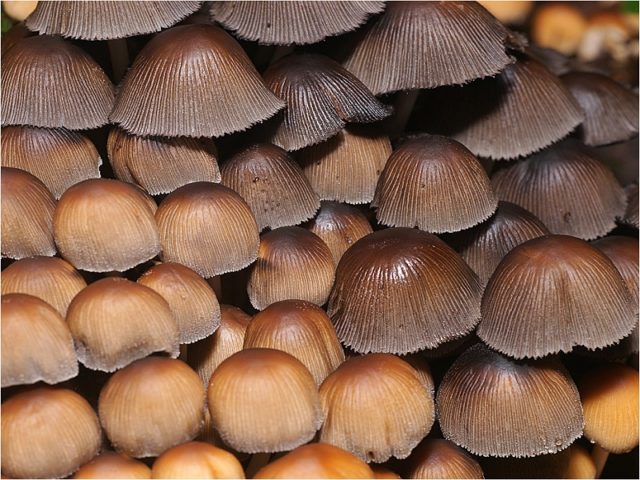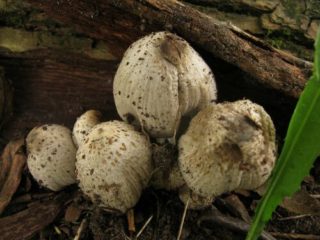Content
The white dung mushroom has a non-standard appearance and color, so there is no consensus on its edibility. In some countries, this variety is collected with pleasure, eaten, and even considered a delicacy; in others, it is considered poisonous.
While there is no evidence that white dung beetle is toxic or hazardous to health, much is known about its beneficial properties.It is not difficult to find such mushrooms; they grow in large groups, but lovers of “quiet hunting” should get to know them as closely as possible in order to learn to identify them by description, distinguish them from similar species, and find out their beneficial and harmful properties.
Where does the white dung mushroom grow?
The white dung beetle (another name is coprinus, or ink dung beetle) is widespread throughout Eurasia, North America, Australia, and in some areas of Africa. It is called “urban” because in the forest this species can only be found in well-lit edges and clearings not shaded by trees. It grows in parks, landfills, stadiums, playgrounds, along highways, near rivers and lakes. In favored places it appears in large groups - 20 - 40 pieces.
The best soil for growth is loose, rich in organic matter, so pastures, vegetable gardens, orchards, and garbage dumps can often become places for collecting mushrooms. The white dung beetle is a saprophyte because it feeds on substances contained in humus, rotten wood or manure. It is moisture-loving, appears in rainy weather, grows rapidly, lives only a few hours, during which time it ripens and decomposes under the influence of its own enzymes, turning into food for new mushrooms.
The collection season begins in May and ends with the arrival of the first frosts, in October.
What does a white dung beetle look like?
The white dung beetle is the most recognizable of the mushrooms of its genus and is the most suitable for culinary purposes.
Thanks to its original appearance, it is extremely difficult to confuse it with any others.
Judging by the photo, when born, the dung beetle mushroom has an oblong cap, ovoid or spindle-shaped, with a height of 5 to 12 cm, and a diameter of 5 to 10 cm.As it grows, its edges move away from the stem, and the shape changes to bell-shaped. Old mushrooms have a cap of the usual shape: hemispherical, slightly convex, with a dark tubercle in the center.
At first, the dung beetle is white, but later the edges of the cap darken, becoming first gray and then completely black.
The surface is covered with scales, which make it look “shaggy”. The pulp of a young mushroom is soft and white, without taste or smell, but in an old one it becomes viscous and black.
The plates located under the cap are often located and are large. At first they are white, then they turn pink and, finally, turn into a black liquid, like the whole cap. For this reason, the mushroom has a second name - ink.
The leg of the white dung beetle has a small diameter - about 2 cm, but a significant length - from 10 to 35 cm. The shape is regular, cylindrical, with a thickening in the form of a bulb in the lower part, hollow inside, fibrous outside. The color of the stem throughout the life of the mushroom is white. It has a movable ring, which turns black over time along with the cap.
More about what coprinus looks like and where it grows in this useful video:
Is the white dung beetle edible or not?
According to its characteristics, white dung beetle is classified as a conditionally edible mushroom of the fourth category. The chemical composition of 100 g of product includes:
- proteins – 3.09 g;
- fats – 0.34 g;
- carbohydrates – 3.26 g;
- fiber – 1 g.
100 g of its pulp contains no more than 22 kcal.
The classification into the 4th category is explained by the fact that the white dung beetle is similar to the poisonous one, it is small in size, fragile and is not particularly popular among mushroom pickers.
The young fruiting body of the white dung beetle is safe for health as long as the cap is ovoid and white in color.As soon as the mushrooms have entered the self-digestion phase and began to darken, they should not be eaten. At this moment they look extremely unattractive, which is also a signal not to use the product. Even collected and frozen young fruiting bodies in their raw form are capable of self-decomposition.
In the specialized literature there are several tips on using coprinuses, among them:
- It is not recommended to mix this species with others during processing;
- collect mushrooms in landfills, garbage dumps, near roads, near industrial enterprises;
- use the product with alcohol.
Taste qualities
The edibility and taste of white dung beetle are viewed differently in different regions. Some consider it poisonous, so they never collect it, while others consider it a delicacy.
Fans of this exotic mushroom are never left without prey, since it prefers to grow in a large company. Coprinus is used for filling pies, soups, snacks, and canning. Experts believe that preparing white dung beetle is not difficult and note its wonderful taste when salted, boiled or fried.
Only young white fruiting bodies are collected; no more than two hours are allocated for their processing so that the process of autolysis (self-digestion) does not begin.
Benefits and harms of white dung mushroom
The beneficial properties of white dung beetles and contraindications for use are associated with the chemical composition of the product, including:
- vitamins of group B, D1, D2, K1, E;
- minerals – zinc, calcium, sodium, phosphorus, selenium, iron, copper, potassium;
- amino acids;
- fructose;
- glucose;
- coprine;
- acids (nicotinic, folic, pantothenic);
- saturated fatty acids;
- trypsin;
- maltase;
- tyrosine and histidine.
Thanks to such a rich chemical composition, white dung beetle is recommended for use for a number of diseases:
- diabetes - due to the hypoglycemic effect;
- prostate adenoma;
- decreased immunity;
- hemorrhoids and constipation - as a pain reliever;
- sluggish digestion;
- joint diseases;
- cardiovascular pathologies - as a preventive measure;
- alcoholism.
Powders or extracts are used for treatment.
Mushroom-based drugs are used to combat alcoholism. The product contains coprine, a substance that prevents the breakdown of alcohol in the human body. Its effect is manifested in human poisoning by undecomposed alcohol products with characteristic accompanying symptoms:
- nausea;
- redness of the skin;
- vomiting;
- strong thirst;
- blurred vision;
- feeling of heat;
- increased heart rate.
These symptoms are present for three days. As a result of using drugs with coprine during a binge, a persistent aversion and aversion to alcohol is developed.
It should be remembered that white dung beetles easily absorb harmful substances from the soil, including heavy metals. For this reason, it is necessary to be careful when choosing places to collect them.
False doubles
The white dung beetle has a unique appearance, which makes it impossible to confuse this representative with other mushrooms, so by definition it has no doubles. Some species are most similar to it.
Dung beetle flickering
The mushroom has an ovoid cap with a diameter of about 4 cm, with grooves. Its color is gray-brown and it is covered with scales. The leg is thin, hollow, fragile. The variety grows on rotten wood. Belongs to the conditionally edible category.
Willow dung beetle
Its cap is whitish, egg-shaped, the grooves on the surface are more pronounced than those of the flickering dung beetle. The edge is uneven, the leg is thin, white, smooth, hollow inside. This species grows everywhere, from May to October. Inedible variety.
Resinous dung beetle
The mushroom has a large egg-shaped cap with scales, which later takes on a bell shape. The leg is long (up to 20 cm), hollow, light, with a slight coating. Has an unpleasant odor. The variety is not eaten.
Dung beetle
The mushroom has a yellowish closed cap, which later becomes lighter and opens. There are folds on its surface. The leg is thin, smooth, light, fragile, often cannot withstand the weight of the cap, breaks, and then the dung beetle dies. The lifespan of the mushroom is about a day. Belongs to the inedible species.
Gray dung beetle
It has an ovoid cap of gray-brown color, with noticeable fibrousness, covered with scales. The plates are grayish, later darken and blur with ink. Spore powder is black. The leg is white, hollow, about 15 cm long. There is no ring on it. Conditionally edible species.
Collection rules
Although the white dung beetle has no dangerous counterparts, you should be careful when collecting mushrooms.To do this, you must follow a number of safety rules:
- find out what a mushroom looks like at different stages of its development;
- do not collect it in landfills where toxic substances may accumulate;
- take only young fruiting bodies with white plates, without signs of the beginning of the autolysis process;
- At home, immediately sort through and remove specimens with pinkish plates;
- process within 2 hours after collection.
How to cook dung beetle mushroom
Despite the strange appearance of the fruiting bodies, the gastronomic characteristics of the product are quite high. There are many recipes from white dung beetle, which can be used to prepare sauces, side dishes, first courses, pickles and marinades.
Trout with mushrooms
Slices of dung beetles are fried in oil with finely chopped garlic. Pour a glass of white wine into the frying pan and simmer for about half an hour under the lid, after which add salt and pepper to taste. Add ½ cup of sour cream and fried trout slices to the prepared mushrooms. The dish is served with greens and new potatoes.
Soup with dung beetles
60 g of millet cereal and finely chopped onion (1 head) are poured into boiling water. Cook the cereal until half cooked. Add potatoes (400 g), cut into strips, and cook until fully cooked. Before the end of cooking, add pieces of pickled white dung beetles (400 g), season with vegetable oil (2 tbsp.), salt and boil for 10 minutes.
Recipes for preparing white dung beetle are distinguished by their variety, ease of execution, combination of various products, and interesting rich taste.The main thing is to have high-quality mushrooms, collected and processed according to all the rules.
Conclusion
The white dung beetle has a strange appearance and a completely unappetizing name. However, with proper collection and preparation, you can get not only tasty, but also healthy dishes.
In many countries, this variety is considered a delicacy and is grown on an industrial scale. It has not yet gained wide popularity among our mushroom pickers, but admirers of the product note its excellent taste.


















